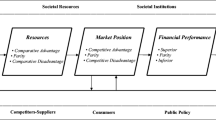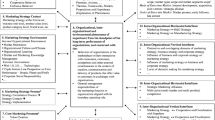Abstract
Resource-Advantage theory has been an important addition to the marketing literature generally, and the marketing strategy literature in particular. Twenty years after its introduction, this paper explores R-A theory in the context of marketing strategy research and considers three main issues. First, while R-A theory has clearly been impactful, why it has not been relatively more impactful. Second, it identifies and elaborates on some important marketing strategy phenomena and questions that have not been explicitly addressed by R-A theory. Third, it offers some suggestions for the further development of R-A theory.
Similar content being viewed by others
Notes
I confess that I have not read every R-A paper and book ever published, and thus such a set of unique R-A theory characteristics and predictions may exist somewhere in the extant literature. However, I would also say that I am not a marketing (or management or economics) theory neophyte—at least relative to the bulk of my colleagues, so this explanation may hold for many marketing academics, even if factually incorrect.
However, I am not sure that this is true with “superior value” vs. “differentiation” in this respect since superior value can be delivered by reducing costs relative to benefits (consistent with a cost-reduction strategy) and by increasing benefits relative to costs which is more consistent with a differentiation strategy (Narver and Slater 1990).
References
Alderson, W. (1957). Marketing behavior and executive action. Homewood: Richard D. Irwin.
Alderson, W. (1965). Dynamic marketing behavior. Homewood: Richard D. Irwin.
Barney, J. (1991). Firm resources and sustained competitive advantage. Journal of management, 17(1), 99–120.
Carpenter, G. S., Glazer, R., & Nakamoto, K. (1994). Meaningful brands from meaningless differentiation: the dependence on irrelevant attributes. Journal of Marketing Research, 31, 339–350.
Hunt, S. D. (2015). The theoretical foundations of strategic marketing and marketing strategy: foundational premises, R-A theory, three fundamental strategies, and societal welfare. AMS Review. doi:10.1007/s13162-015-0069-5
Hunt, S. D., & Morgan, R. M. (1995). The comparative advantage theory of competition. Journal of Marketing, 59(2), 1–15.
Hunt, S. D., & Morgan, R. M. (1996). The resource-advantage theory of competition: dynamics, path dependencies, and evolutionary dimensions. Journal of marketing, 107–114.
Hunt, S. D. (2000). A General Theory of Competition: Resources, Competences, Productivity, Economic Growth. Thousand Oaks, CA: Sage Publications.
Madhavaram, S., & Hunt, S. D. (2008). The service-dominant logic and a hierarchy of operant resources: developing masterful operant resources and implications for marketing strategy. Journal of the Academy of Marketing Science, 36(1), 67–82.
Morgan, N. A. (2012). Marketing and business performance. Journal of the Academy of Marketing Science, 40(1), 102–119.
Morgan, R. M., & Hunt, S. D. (1994). The commitment-trust theory of relationship marketing. Journal of marketing, 20–38.
Narver, J. C., & Slater, S. F. (1990). The effect of a market orientation on business profitability. Journal of Marketing, 20–35.
Rust, R. T., Moorman, C., & Dickson, P. R. (2002). Getting return on quality: revenue expansion, cost reduction, or both? Journal of Marketing, 66(4), 7–24.
Teece, D. J., Pisano, G., & Shuen, A. (1997). Dynamic capabilities and strategic management. Strategic management journal, 18(7), 509–533.
Varadarajan, R. (2010). Strategic marketing and marketing strategy: domain, definition, fundamental issues and foundational premises. Journal of the Academy of Marketing Science, 38(2), 119–140.
Vorhies, D. W., & Morgan, N. A. (2003). A configuration theory assessment of marketing organization fit with business strategy and its relationship with marketing performance. Journal of Marketing, 67(1), 100–115.
Vorhies, D. W., & Morgan, N. A. (2005). Benchmarking marketing capabilities for sustained competitive advantage. Journal of Marketing, 69(1), 80–94.
Wernerfelt, B. (1984). A resource-based view of the firm. Strategic management journal, 5(2), 171–180.
Author information
Authors and Affiliations
Corresponding author
Rights and permissions
About this article
Cite this article
Morgan, N.A. Commentary on Shelby Hunt’s “The theoretical foundations of strategic marketing and marketing strategy: foundational premises, R-A theory, three fundamental strategies, and societal welfare”. AMS Rev 5, 91–97 (2015). https://doi.org/10.1007/s13162-015-0070-z
Received:
Accepted:
Published:
Issue Date:
DOI: https://doi.org/10.1007/s13162-015-0070-z




